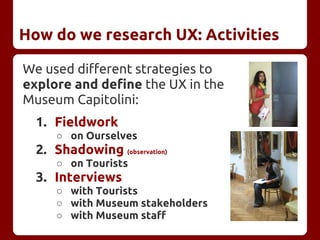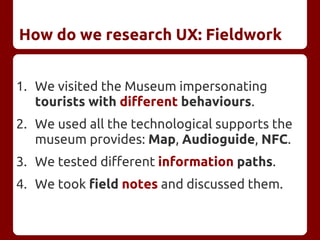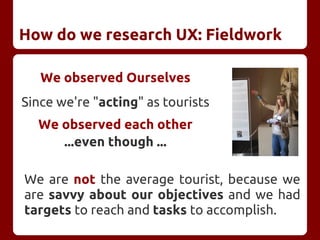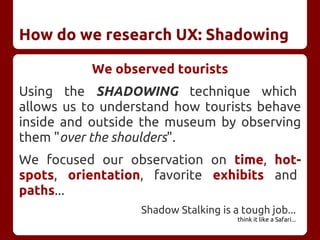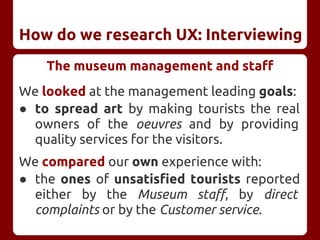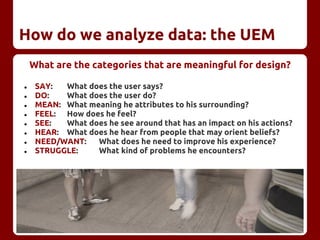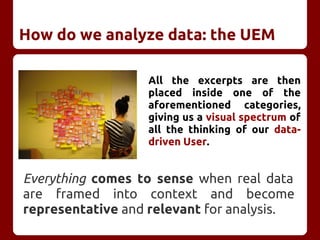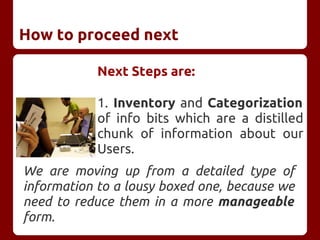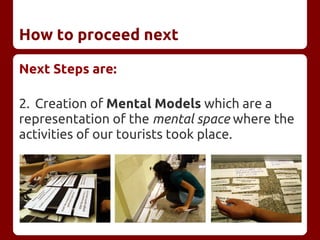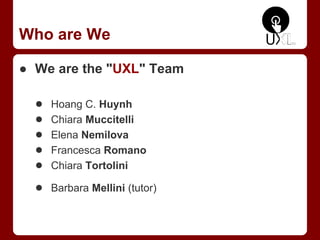Ux research evolaris
- 1. User eXperience Research Exploring UX in Musei Capitolini
- 2. Just a brief sketch to frame our work ÔùÅ Why to research Users? ÔùÅ How do we explore UX? ÔùÅ How do we analyse the data? ÔùÅ How to proceed to design?
- 3. UX Research: Why? Early focus on Users and Tasks ÔÇ£ First, designers must understand who the user will be. This understanding is arrived at in part by directly studying their cognitive, behavioral, anthropometric and attitudinal characteristics, and in part by studying the nature of the work expected to be accomplished ÔÇØ [Gould and Lewis, 1985]
- 4. Why research Users Users are observed in their own environment, in order to understand the context of their daily practices. We have to pay attention to struggles, difficulties, needs and expectations.
- 5. Why research Users We observe because ÔùÅ Users are not able to make a clear distinction between their needs and their desires ÔùÅ Users are not able to explain something they know nothing about ÔùÅ Users will try to conceal their problems if asked directly ÔùÅ We are somehow biased into finding problems and the last thing we want to do is to suggest problems
- 6. How do we research UX: Activities We used different strategies to explore and define the UX in the Museum Capitolini: 1. Fieldwork Ôùï on Ourselves 2. Shadowing (observation) Ôùï on Tourists 3. Interviews Ôùï with Tourists Ôùï with Museum stakeholders Ôùï with Museum staff
- 7. How do we research UX: Fieldwork 1. We visited the Museum impersonating tourists with different behaviours. 2. We used all the technological supports the museum provides: Map, Audioguide, NFC. 3. We tested different information paths. 4. We took field notes and discussed them.
- 8. How do we research UX: Fieldwork We observed Ourselves Since we're "acting" as tourists We observed each other ...even though ... We are not the average tourist, because we are savvy about our objectives and we had targets to reach and tasks to accomplish.
- 9. How do we research UX: Shadowing We observed tourists Using the SHADOWING technique which allows us to understand how tourists behave inside and outside the museum by observing them "over the shoulders". We focused our observation on time, hot- spots, orientation, favorite exhibits and paths... Shadow Stalking is a tough job... think it like a Safari...
- 10. How do we research UX: Interviewing The museum management and staff We looked at the management leading goals: ÔùÅ to spread art by making tourists the real owners of the oeuvres and by providing quality services for the visitors. We compared our own experience with: ÔùÅ the ones of unsatisfied tourists reported either by the Museum staff, by direct complaints or by the Customer service.
- 11. Tourists on site 1. We interviewed tourists of different genre and types from all over the world. 2. We get to know them a little by asking how they got there and their motivations. 3. We asked what did they expect to find before they enter the museum. 4. We asked how was their experience of the museum once their visit was over. How do we research UX: Interviewing
- 12. We asked ourselves 2 (simple) questions ÔùÅ Who is our User? ÔùÅ What do We know about him? ...and We found out that these questions are not simple at all...
- 13. How do we analyze data We gathered meaningful excerpts from our interviews and start seeing patterns and behaviours, along with unexpected user needs. "We just love to walk around and see local people"(couple, 20 y.o., RU) "We are interested in Ancient Rome history" (couple, 30 y.o., RU) "I just wander around the museum"(visitor, 30 y.o., USA) "It seems that the museums of Rome have not a clear historical path" (couple, 30 y.o., ESP) "I only know there's the Shewolf inside the museum" (couple, 30 y.o., RU) "We read information stands to know the name of the exhibit" (3 girls, 20 y.o., GER) "They would like to have more information about orientation inside" (2 friends, 20 y.o., USA) "We don't understand how to use this map to visit the museum" (3 girls, 20 y.o., USA) "The visit path was ok, but i would like to have had some more light that would improve the fruition of the paintings" (visitor, 83 y.o., ITA) Time to frame these data into a valuable tool to assist our analysis!
- 14. How do we analyze data: the UEM The User Ethnographic Map (UEM) is a specific tool for analysing extremely heterogeneous data that works as a bridge between the ethnographic research and the design phase. How? It highlights specific categories related to how the user acts in his natural context which are crucial for the design thinking. The main difference between the classic designers "Empathy Map" and the "User Ethnographic Map" is the strong focus on research data.
- 15. How do we analyze data: the UEM What are the categories that are meaningful for design? ÔùÅ SAY: What does the user says? ÔùÅ DO: What does the user do? ÔùÅ MEAN: What meaning he attributes to his surrounding? ÔùÅ FEEL: How does he feel? ÔùÅ SEE: What does he see around that has an impact on his actions? ÔùÅ HEAR: What does he hear from people that may orient beliefs? ÔùÅ NEED/WANT: What does he need to improve his experience? ÔùÅ STRUGGLE: What kind of problems he encounters?
- 16. How do we analyze data: the UEM All the excerpts are then placed inside one of the aforementioned categories, giving us a visual spectrum of all the thinking of our data- driven User. Everything comes to sense when real data are framed into context and become representative and relevant for analysis.
- 17. How to proceed next Next Steps are: 1. Inventory and Categorization of info bits which are a distilled chunk of information about our Users. We are moving up from a detailed type of information to a lousy boxed one, because we need to reduce them in a more manageable form.
- 18. How to proceed next Next Steps are: 2. Creation of Mental Models which are a representation of the mental space where the activities of our tourists took place.
- 19. Who are We ÔùÅ We are the "UXL" Team ÔùÅ Hoang C. Huynh ÔùÅ Chiara Muccitelli ÔùÅ Elena Nemilova ÔùÅ Francesca Romano ÔùÅ Chiara Tortolini ÔùÅ Barbara Mellini (tutor)

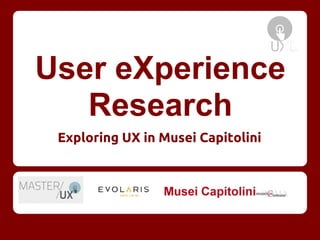
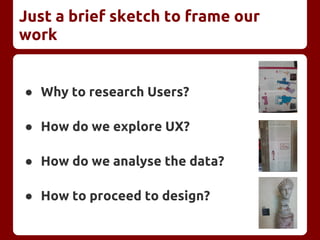
![UX Research: Why?
Early focus on Users and Tasks
ÔÇ£ First, designers must understand who the user will be.
This understanding is arrived at in part by directly
studying their cognitive, behavioral, anthropometric and
attitudinal characteristics, and in part by studying the
nature of the work expected to be accomplished ÔÇØ
[Gould and Lewis, 1985]](https://image.slidesharecdn.com/uxresearchevolaris-130607033154-phpapp01/85/Ux-research-evolaris-3-320.jpg)


